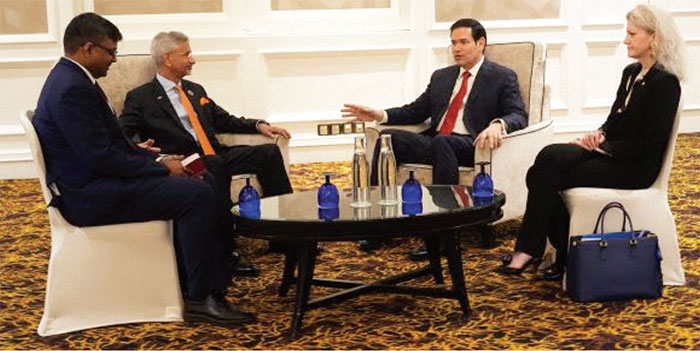SUKUMAR SAH
US Secretary of State Marco Rubio’s meeting with India’s External Affairs Minister S. Jaishankar in Kuala Lumpur on the sidelines of the 48th Asean Summit a few days ago has drawn attention far beyond the diplomatic circles.
Ostensibly a courtesy call, it carried the undertone of reassurance — that despite Donald Trump’s sharp rhetoric and tariff threats, Washington values New Delhi as a strategic partner. For India, the meeting was a test of intent: Is Trump’s America still a reliable friend, or a transactional power recalibrating its interests?
Rubio, a prominent Republican voice and one of Trump’s closest Senate allies, has been at the forefront of advocating a tougher stance on China while strengthening Indo-Pacific partnerships.
His quiet diplomacy with Jaishankar sought to balance Trump’s abrasive style with institutional continuity. By underscoring bipartisan support for India, Rubio aimed to soothe apprehensions emerging in New Delhi’s policy circles after the US imposed fresh tariffs on Indian steel and pharmaceuticals earlier this year.
The timing was critical. Public sentiment in India, once overwhelmingly favourable to the US, has begun to slip. Surveys show a drop from 65 per cent in 2023 to barely above 50 per cent in mid-2025, with a growing perception that Washington’s “America First” trade agenda sidelines partners like India. The broader worry is that Trump 2.0 may view alliances primarily through the lens of short-term economic gains rather than strategic trust.
Rubio’s intervention thus sought to reaffirm the pillars of the India-US partnership — technology collaboration, defence cooperation, and democratic alignment. He reportedly discussed expanding semiconductor investments, joint defence production, and resilient supply chains, areas that dovetail with India’s ambition to emerge as an alternative to China in global manufacturing. For New Delhi, these commitments matter: They signal that the US relationship is more than a balance-sheet calculation.
Yet the symbolism cannot mask the asymmetry. While the US counts India as a crucial partner in its Indo-Pacific strategy, it has not hesitated to press New Delhi on trade barriers, data localisation, and its ties with Moscow.
India’s refusal to join Western sanctions on Russia continues to irk Washington. Rubio’s charm offensive, therefore, is also a recognition that coercion has limits; persuasion works better when the goal is to keep India in the US strategic fold.
By underscoring bipartisan support for India, Rubio aimed to soothe apprehensions emerging in New Delhi’s policy circles after the US imposed fresh tariffs on Indian steel and pharmaceuticals earlier this year
From New Delhi’s perspective, the meeting also served a dual purpose. It reminded Washington that India’s partnership is not automatic — it must be earned through respect for India’s economic priorities and strategic autonomy.
Jaishankar’s measured tone, emphasising “mutual interests and mutual sensitivity,” hinted at quiet firmness. India welcomes American engagement but will not be lectured or strong-armed.
Ultimately, Rubio’s outreach was less about immediate deliverables and more about optics — an attempt to restore faith amid uncertainty. It conveyed that despite Trump’s unpredictability, parts of the US establishment still see India as central to America’s long-term interests.
Whether that message translates into trust on the Indian street remains to be seen, but for now, diplomacy has bought time — and perhaps, a little more faith — in Trump’s America.



